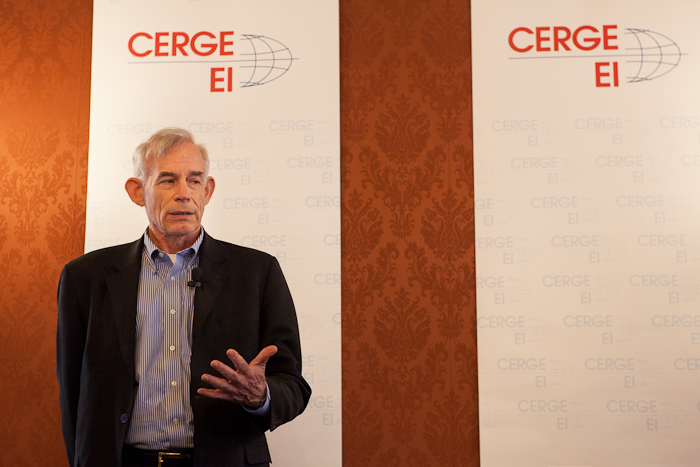Christopher Sims won the Nobel Prize in Economic Sciences in 2011. When he came to CERGE-EI this summer to lecture about his research, we knew we had to sit down with Professor Sims for a more intimate interview. Take a look at the conversation between this brilliant laureate and some of our PhD students at CERGE-EI:
What can you tell us about the journey to winning the Nobel Prize? Where you got your ideas, who influenced you the most, the evolution of the research?
My Nobel Prize is focused on the empirical econometric work I did on monetary policy. My ‘Noble lecture’ kind of goes through that, but I can summarize it: In the 1950s and early 1960s, Keynesian Economics was dominant. And in the 50s, which was very close to the Great Depression, the Keynesian consensus was that monetary policy was not very important and fiscal policy was. And this was a legacy of the period of the Liquidity Trap in the 1930s, when monetary policy indeed was not very effective—a period much like the present, in that respect.
Back then, econometricians developed large statistical models, based on Keysian Theory. They built on the insights of Trygve Haavelmo and Jan Tinbergen, two earlier Nobel Prize winners. And they ended up with very large unwieldy models, for which the statistical methods proposed by Haavelmo didn’t really work very well.
 So into this scene came the monetarists led by Milton Friedman, and they used much simpler statistical models and focused on just a few variables. They argued that the connection between the money stock and income was the central, most important fact in macroeconomics. But this factor didn’t emerge as central and important from the perspective of those big Keynesian models.
So into this scene came the monetarists led by Milton Friedman, and they used much simpler statistical models and focused on just a few variables. They argued that the connection between the money stock and income was the central, most important fact in macroeconomics. But this factor didn’t emerge as central and important from the perspective of those big Keynesian models.
There was really no way for these two schools to resolve their differences with the econometric methods that were available at the time. But in the big Keynesian models, everyone knew they made assumptions that weren’t believable.
So what I did was first I validated the monetarists. They were running regressions of nominal GDP on current and past money stock, and interpreting them as policy-exploitable relationships. They interpreted them as if changing the money stock would change nominal GDP according to the coefficients they estimated in those models. I argued that if that were true, there was a testable implication. This was a causal model. In this logic, future money should not be correlated with income, given past money. So I checked that implication and it turned out that the implication was satisfied by the data.
And so something that both Keynesians and I would have predicted would show that the monetarists were wrong, actually showed they were probably right.
But then a student of mine, Yash Mehra, did a study of so-called ‘Money Demand Equations’. Because at the same time that Friedman was estimating these income-on-money regressions, other people were putting money on the left side and income and interest rates on the right. They were calling this ‘money demand’, and it was another similar equation regression. So I said to Mehra: ‘this looks like a good thing to check, because If money is causing income, than these money demand equations must be nonsense. Money doesn’t belong on the left-hand side.’
But Mahra did the tests and it turned out they passed. He showed that with money on the left and income and interest rates on the right, it looked like everything on the right-hand side satisfied this condition that the future size of the variables shouldn’t matter.
I was puzzled by these results and decided that I wasn’t going to make sense of them unless I put together a model with more than one equation. So I estimated a small, vector regression with several equations, and once I did that I could see that interest rates predict money, and if that’s right, then the usual ‘monetarist’ interpretation of this system didn’t really hold up.
So there is a kind of consensus now on how the economy dynamically responds to monetary expansion or tightening. It’s not really precise, but GDP tends to respond a little quicker than prices, and they both tend to go down when money is tightened. These come right out of quantitative statistical estimates, and there are different ways to do the identification, to separate these two influences. And they give consistent results. That was what the prize was for, that sequence of developments.
Continue reading Nobel Pursuits: CERGE-EI Interviews Nobel Prize Winner Christopher Sims
